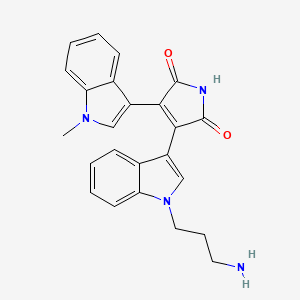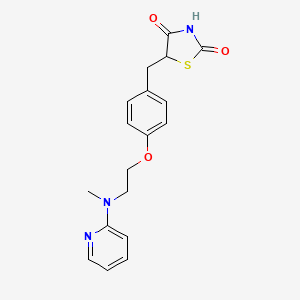
Rosiglitazone
Vue d'ensemble
Description
La rosiglitazone est un composé synthétique appartenant à la classe des médicaments thiazolidinediones. Il est principalement utilisé comme agent antidiabétique pour améliorer le contrôle glycémique chez les patients atteints de diabète de type 2. La this compound fonctionne comme un sensibilisateur à l’insuline en se liant aux récepteurs activés par les proliférateurs de peroxysomes dans les cellules graisseuses, augmentant ainsi la sensibilité des cellules à l’insuline .
Mécanisme D'action
La rosiglitazone exerce ses effets en activant la classe de récepteurs intracellulaires des récepteurs activés par les proliférateurs de peroxysomes, plus précisément le PPAR-gamma. Cette activation influence la production de produits géniques impliqués dans le métabolisme du glucose et des lipides. La this compound est un ligand sélectif du PPAR-gamma et ne se lie pas au PPAR-alpha. Outre son effet sur la résistance à l’insuline, elle semble également avoir des effets anti-inflammatoires en modulant les niveaux du facteur nucléaire kappa-B .
Applications De Recherche Scientifique
Rosiglitazone has a wide range of scientific research applications:
Chemistry: Used as a model compound in studies of thiazolidinedione synthesis and reaction mechanisms.
Biology: Investigated for its effects on insulin sensitivity and glucose metabolism.
Medicine: Primarily used to treat type 2 diabetes mellitus by improving insulin sensitivity.
Industry: Utilized in the pharmaceutical industry for the production of antidiabetic medications.
Analyse Biochimique
Biochemical Properties
Rosiglitazone works by activating the intracellular receptor class of the peroxisome proliferator-activated receptors (PPARs), specifically PPARγ . It is a selective ligand of PPARγ, and has no PPARα-binding action . Apart from its effect on insulin resistance, it appears to have an anti-inflammatory effect .
Cellular Effects
This compound has been shown to suppress the growth of human glioma cell lines U87 and U251 . It also induces cell cycle arrest and apoptosis . In addition, this compound has been found to exhibit anti-inflammatory properties and can target cardiomyocytes secreting CXCL10, under interferon (IFN)γ and tumor necrosis factor (TNF)α challenge .
Molecular Mechanism
The mechanism of action of this compound is by activation of the intracellular receptor class of the peroxisome proliferator-activated receptors (PPARs), specifically PPARγ . This compound is a selective ligand of PPARγ, and has no PPARα-binding action . Apart from its effect on insulin resistance, it appears to have an anti-inflammatory effect: nuclear factor kappa-B (NFκB) levels fall and inhibitor (IκB) levels increase in patients on this compound .
Temporal Effects in Laboratory Settings
This compound has been shown to have a significant effect on the reduction of glucose and HbA1c treatment effects in rats . This effect was observed over a period of 6 weeks of treatment with this compound .
Dosage Effects in Animal Models
In animal models, this compound has been shown to be the most effective treatment in thiazolidinediones (TZDs) not only for its hypoglycemic effect but also for its additional effects such as anti-inflammatory and anti-cancer capabilities, retinopathy, and ischemia–reperfusion injury protection effects .
Metabolic Pathways
This compound is extensively metabolized in the liver to inactive metabolites via N-demethylation, hydroxylation, and conjugation with sulfate and glucuronic acid . In vitro data have shown that Cytochrome (CYP) P450 isoenzyme 2C8 (CYP2C8) and to a minor extent CYP2C9 are involved in the hepatic metabolism of this compound .
Transport and Distribution
This compound is primarily distributed in the liver, where it is extensively metabolized . It is also distributed in fat cells, where it works as an insulin sensitizer, by binding to the PPAR in fat cells and making the cells more responsive to insulin .
Subcellular Localization
This compound acts at the level of the nucleus, where it binds to the peroxisome proliferator-activated receptors (PPARs), specifically PPARγ . This binding activates the PPARγ, leading to the transcription of insulin-responsive genes involved in the control of glucose production, transport, and utilization .
Méthodes De Préparation
Voies de synthèse et conditions de réaction
La synthèse de la rosiglitazone implique plusieurs étapes clés :
Réaction de la 2-chloropyridine avec le 2-méthylaminoéthanol : Cette réaction est catalysée par le sodium trityle pour produire du 2-[N-méthyl-N-(2-pyridine)amino]éthanol.
Réaction de synthèse de Williamson : Le benzaldéhyde N-substitué et le 4-fluorobenzaldéhyde subissent une réaction de synthèse de Williamson catalysée par le potassium bis(triméthylsilyl)amino pour former du 4-[2-[N-méthyl-N-(2-pyridine)amino]éthoxy]benzaldéhyde.
Réaction de condensation : Le composé résultant est ensuite condensé avec la thiazoline-2,4-dicétone pour produire de la 5-{4-[2-[N-méthyl-N-(2-pyridine)amino]éthoxy]benzylidène}thiazoline-2,4-dicétone.
Réaction de réduction : Enfin, le composé subit une réaction de réduction catalysée par un réactif organique au manganèse pour produire de la this compound.
Méthodes de production industrielle
Pour la production industrielle, la synthèse de la this compound est optimisée pour la mise à l’échelle et l’efficacité. Le processus implique une voie de synthèse en cinq étapes avec des matières premières disponibles dans le commerce, notamment la 2-chloropyridine, la N-méthyléthanolamine, le 4-fluorobenzaldéhyde et la 1,3-thiazolidine-2,4-dione. Les étapes comprennent la cyclisation, l’alkylation, l’éthérification, la condensation et la réduction, avec un rendement global d’environ 40 % .
Analyse Des Réactions Chimiques
Types de réactions
La rosiglitazone subit diverses réactions chimiques, notamment :
Condensation : La réaction de condensation avec la thiazoline-2,4-dicétone est une étape cruciale de sa synthèse.
Réactifs et conditions courants
Borohydrure de sodium : Utilisé dans l’étape de réduction.
Hexahydrate de chlorure de cobalt et diméthylglyoxime : Catalyseurs de la réaction de réduction.
Sodium trityle : Catalyseur de la réaction de la 2-chloropyridine avec le 2-méthylaminoéthanol.
Potassium bis(triméthylsilyl)amino : Catalyseur de la réaction de synthèse de Williamson.
Principaux produits formés
Le principal produit formé à partir de ces réactions est la this compound elle-même, avec des composés intermédiaires tels que le 2-[N-méthyl-N-(2-pyridine)amino]éthanol et le 4-[2-[N-méthyl-N-(2-pyridine)amino]éthoxy]benzaldéhyde .
Applications de recherche scientifique
La this compound a un large éventail d’applications de recherche scientifique :
Chimie : Utilisée comme composé modèle dans les études de synthèse des thiazolidinediones et de mécanismes réactionnels.
Biologie : Étudiée pour ses effets sur la sensibilité à l’insuline et le métabolisme du glucose.
Médecine : Principalement utilisée pour traiter le diabète de type 2 en améliorant la sensibilité à l’insuline.
Industrie : Utilisée dans l’industrie pharmaceutique pour la production de médicaments antidiabétiques.
Comparaison Avec Des Composés Similaires
Composés similaires
Pioglitazone : Une autre thiazolidinedione utilisée pour traiter le diabète de type 2.
Troglitazone : Une thiazolidinedione qui a été retirée du marché en raison de préoccupations concernant l’hépatotoxicité.
Unicité de la rosiglitazone
La this compound est unique en raison de sa liaison spécifique au PPAR-gamma sans affecter le PPAR-alpha. Comparée à la pioglitazone, la this compound a été associée à un risque plus élevé d’infarctus du myocarde et d’insuffisance cardiaque congestive, ce qui a soulevé des inquiétudes quant à la sécurité . Elle demeure un sensibilisateur à l’insuline efficace et a été explorée pour des applications thérapeutiques supplémentaires au-delà du traitement du diabète .
Propriétés
IUPAC Name |
5-[[4-[2-[methyl(pyridin-2-yl)amino]ethoxy]phenyl]methyl]-1,3-thiazolidine-2,4-dione | |
|---|---|---|
| Source | PubChem | |
| URL | https://pubchem.ncbi.nlm.nih.gov | |
| Description | Data deposited in or computed by PubChem | |
InChI |
InChI=1S/C18H19N3O3S/c1-21(16-4-2-3-9-19-16)10-11-24-14-7-5-13(6-8-14)12-15-17(22)20-18(23)25-15/h2-9,15H,10-12H2,1H3,(H,20,22,23) | |
| Source | PubChem | |
| URL | https://pubchem.ncbi.nlm.nih.gov | |
| Description | Data deposited in or computed by PubChem | |
InChI Key |
YASAKCUCGLMORW-UHFFFAOYSA-N | |
| Source | PubChem | |
| URL | https://pubchem.ncbi.nlm.nih.gov | |
| Description | Data deposited in or computed by PubChem | |
Canonical SMILES |
CN(CCOC1=CC=C(C=C1)CC2C(=O)NC(=O)S2)C3=CC=CC=N3 | |
| Source | PubChem | |
| URL | https://pubchem.ncbi.nlm.nih.gov | |
| Description | Data deposited in or computed by PubChem | |
Molecular Formula |
C18H19N3O3S | |
| Source | PubChem | |
| URL | https://pubchem.ncbi.nlm.nih.gov | |
| Description | Data deposited in or computed by PubChem | |
DSSTOX Substance ID |
DTXSID7037131 | |
| Record name | Rosiglitazone | |
| Source | EPA DSSTox | |
| URL | https://comptox.epa.gov/dashboard/DTXSID7037131 | |
| Description | DSSTox provides a high quality public chemistry resource for supporting improved predictive toxicology. | |
Molecular Weight |
357.4 g/mol | |
| Source | PubChem | |
| URL | https://pubchem.ncbi.nlm.nih.gov | |
| Description | Data deposited in or computed by PubChem | |
Physical Description |
Solid | |
| Record name | Rosiglitazone | |
| Source | Human Metabolome Database (HMDB) | |
| URL | http://www.hmdb.ca/metabolites/HMDB0005031 | |
| Description | The Human Metabolome Database (HMDB) is a freely available electronic database containing detailed information about small molecule metabolites found in the human body. | |
| Explanation | HMDB is offered to the public as a freely available resource. Use and re-distribution of the data, in whole or in part, for commercial purposes requires explicit permission of the authors and explicit acknowledgment of the source material (HMDB) and the original publication (see the HMDB citing page). We ask that users who download significant portions of the database cite the HMDB paper in any resulting publications. | |
Mechanism of Action |
Rosiglitazone acts as a highly selective and potent agonist at peroxisome proliferator activated receptors (PPAR) in target tissues for insulin action such as adipose tissue, skeletal muscle, and liver. Activation of PPAR-gamma receptors regulates the transcription of insulin-responsive genes involved in the control of glucose production, transport, and utilization. In this way, rosiglitazone enhances tissue sensitivity to insulin., Because osteoblasts and marrow adipocytes are derived from a common mesenchymal progenitor, increased adipogenesis may occur at the expense of osteoblasts, leading to bone loss. Our previous in vitro studies indicated that activation of the proadipogenic transcription factor peroxisome proliferator-activated receptor isoform gamma 2 with rosiglitazone suppressed osteoblast differentiation. Here, we show that 5-month-old Swiss-Webster mice receiving rosiglitazone for 28 day exhibited bone loss associated with an increase in marrow adipocytes, a decrease in the ratio of osteoblasts to osteoclasts, a reduction in bone formation rate, and a reduction in wall width--an index of the amount of bone formed by each team of osteoblasts. Rosiglitazone had no effect on the number of early osteoblast or osteoclast progenitors, or on osteoblast life span, but decreased the expression of the key osteoblastogenic transcription factors Runx2 and Osterix in cultures of marrow-derived mesenchymal progenitors. These effects were associated with diversion of bipotential progenitors from the osteoblast to the adipocyte lineage, and suppression of the differentiation of monopotential osteoblast progenitors. However, rosiglitazone had no effect on osteoblastic cells at later stages of differentiation. Hence, rosiglitazone attenuates osteoblast differentiation and thereby reduces bone formation rate in vivo, leading to bone loss. These findings provide a mechanistic explanation for the recent evidence that peroxisome proliferator-activated receptor isoform gamma activation is a negative regulator of bone mass and suggest that the increased production of oxidized fatty acids with age may indeed be an important mechanism for age-related osteoporosis in humans., Brain peroxisome proliferator-activated receptor gamma (PPARgamma), a member of the nuclear receptor superfamily of ligand-dependent transcription factors, is involved in neuroprotection. It is activated by the drug rosiglitazone, which then can increase the pro-survival protein B-cell lymphoma 2 (BCL-2), to mediate neuroprotection. However, the mechanism underlying this molecular cascade remains unknown. Here, we show that the neuroprotective protein neurotrophic factor-a1 (NF-a1), which also induces the expression of BCL-2, has a promoter that contains PPARgamma-binding sites that are activated by rosiglitazone. Treatment of Neuro2a cells and primary hippocampal neurons with rosiglitazone increased endogenous NF-a1 expression and prevented H2 O2 -induced cytotoxicity. Concomitant with the increase in NF-a1, BCL-2 was also increased in these cells. When siRNA against NF-a1 was used, the induction of BCL-2 by rosiglitazone was prevented, and the neuroprotective effect of rosiglitazone was reduced. These results demonstrate that rosiglitazone-activated PPARgamma directly induces the transcription of NF-a1, contributing to neuroprotection in neurons. We proposed the following cascade for neuroprotection against oxidative stress by rosiglitazone: Rosiglitazone enters the neuron and binds to peroxisome proliferator-activated receptor gamma (PPARgamma) in the nucleus. The PPARgamma-rosiglitazone complex binds to the neurotrophic factor-a1 (NF-a1) promoter and activates the transcription of NF-a1 mRNA which is then translated to the protein. NF-a1 is the secreted, binds to a cognate receptor and activates the extracellular signal-regulated kinases (ERK) pathway. This in turn enhances the expression of the pro-survival protein, B-cell lymphoma 2 (BCL-2) and inhibition of caspase 3 (Csp-3) to mediate neuroprotection under oxidative stress. Akt, protein kinase B (PKB)., Rosiglitazone, a member of the thiazolidinedione class of antidiabetic agents, improves glycemic control by improving insulin sensitivity. Rosiglitazone is a highly selective and potent agonist for the peroxisome proliferator-activated receptor-gamma (PPARgamma). In humans, PPAR receptors are found in key target tissues for insulin action such as adipose tissue, skeletal muscle, and liver. Activation of PPARgamma nuclear receptors regulates the transcription of insulin-responsive genes involved in the control of glucose production, transport, and utilization. In addition, PPARgamma- responsive genes also participate in the regulation of fatty acid metabolism, Rosiglitazone acts principally by increasing insulin sensitivity in target tissues, as well as decreasing hepatic gluconeogenesis. Rosiglitazone is a peroxisome proliferator-activated receptorgamma (PPARgamma) agonist that increases transcription of insulin-responsive genes and increases insulin sensitivity. Rosiglitazone, like other thiazolidinediones, ameliorates insulin resistance associated with type diabetes mellitus without stimulating insulin release from pancreatic beta cells, thus avoiding the risk of hypoglycemia. Because rosiglitazone does not lower glucose concentrations below euglycemia, the drug is appropriately referred to as an antidiabetic agent rather than a hypoglycemic agent. Some evidence suggests that the glucoregulatory effects of thiazolidinediones are mediated in part via reduced systemic and tissue lipid availability. Circulating concentrations of insulin and C-peptide are reduced during rosiglitazone therapy. | |
| Record name | Rosiglitazone | |
| Source | DrugBank | |
| URL | https://www.drugbank.ca/drugs/DB00412 | |
| Description | The DrugBank database is a unique bioinformatics and cheminformatics resource that combines detailed drug (i.e. chemical, pharmacological and pharmaceutical) data with comprehensive drug target (i.e. sequence, structure, and pathway) information. | |
| Explanation | Creative Common's Attribution-NonCommercial 4.0 International License (http://creativecommons.org/licenses/by-nc/4.0/legalcode) | |
| Record name | Rosiglitazone | |
| Source | Hazardous Substances Data Bank (HSDB) | |
| URL | https://pubchem.ncbi.nlm.nih.gov/source/hsdb/7555 | |
| Description | The Hazardous Substances Data Bank (HSDB) is a toxicology database that focuses on the toxicology of potentially hazardous chemicals. It provides information on human exposure, industrial hygiene, emergency handling procedures, environmental fate, regulatory requirements, nanomaterials, and related areas. The information in HSDB has been assessed by a Scientific Review Panel. | |
Color/Form |
Colorless crystals from methanol | |
CAS No. |
122320-73-4 | |
| Record name | Rosiglitazone | |
| Source | CAS Common Chemistry | |
| URL | https://commonchemistry.cas.org/detail?cas_rn=122320-73-4 | |
| Description | CAS Common Chemistry is an open community resource for accessing chemical information. Nearly 500,000 chemical substances from CAS REGISTRY cover areas of community interest, including common and frequently regulated chemicals, and those relevant to high school and undergraduate chemistry classes. This chemical information, curated by our expert scientists, is provided in alignment with our mission as a division of the American Chemical Society. | |
| Explanation | The data from CAS Common Chemistry is provided under a CC-BY-NC 4.0 license, unless otherwise stated. | |
| Record name | Rosiglitazone [INN:BAN] | |
| Source | ChemIDplus | |
| URL | https://pubchem.ncbi.nlm.nih.gov/substance/?source=chemidplus&sourceid=0122320734 | |
| Description | ChemIDplus is a free, web search system that provides access to the structure and nomenclature authority files used for the identification of chemical substances cited in National Library of Medicine (NLM) databases, including the TOXNET system. | |
| Record name | Rosiglitazone | |
| Source | DrugBank | |
| URL | https://www.drugbank.ca/drugs/DB00412 | |
| Description | The DrugBank database is a unique bioinformatics and cheminformatics resource that combines detailed drug (i.e. chemical, pharmacological and pharmaceutical) data with comprehensive drug target (i.e. sequence, structure, and pathway) information. | |
| Explanation | Creative Common's Attribution-NonCommercial 4.0 International License (http://creativecommons.org/licenses/by-nc/4.0/legalcode) | |
| Record name | rosiglitazone | |
| Source | DTP/NCI | |
| URL | https://dtp.cancer.gov/dtpstandard/servlet/dwindex?searchtype=NSC&outputformat=html&searchlist=758698 | |
| Description | The NCI Development Therapeutics Program (DTP) provides services and resources to the academic and private-sector research communities worldwide to facilitate the discovery and development of new cancer therapeutic agents. | |
| Explanation | Unless otherwise indicated, all text within NCI products is free of copyright and may be reused without our permission. Credit the National Cancer Institute as the source. | |
| Record name | Rosiglitazone | |
| Source | EPA DSSTox | |
| URL | https://comptox.epa.gov/dashboard/DTXSID7037131 | |
| Description | DSSTox provides a high quality public chemistry resource for supporting improved predictive toxicology. | |
| Record name | 5-(4-(2-(N-METHYL-N-(2-PYRIDYL)AMINO)ETHOXY)BENZYL)THIAZOLIDINE-2,4 -DIONE | |
| Source | European Chemicals Agency (ECHA) | |
| URL | https://echa.europa.eu/information-on-chemicals | |
| Description | The European Chemicals Agency (ECHA) is an agency of the European Union which is the driving force among regulatory authorities in implementing the EU's groundbreaking chemicals legislation for the benefit of human health and the environment as well as for innovation and competitiveness. | |
| Explanation | Use of the information, documents and data from the ECHA website is subject to the terms and conditions of this Legal Notice, and subject to other binding limitations provided for under applicable law, the information, documents and data made available on the ECHA website may be reproduced, distributed and/or used, totally or in part, for non-commercial purposes provided that ECHA is acknowledged as the source: "Source: European Chemicals Agency, http://echa.europa.eu/". Such acknowledgement must be included in each copy of the material. ECHA permits and encourages organisations and individuals to create links to the ECHA website under the following cumulative conditions: Links can only be made to webpages that provide a link to the Legal Notice page. | |
| Record name | ROSIGLITAZONE | |
| Source | FDA Global Substance Registration System (GSRS) | |
| URL | https://gsrs.ncats.nih.gov/ginas/app/beta/substances/05V02F2KDG | |
| Description | The FDA Global Substance Registration System (GSRS) enables the efficient and accurate exchange of information on what substances are in regulated products. Instead of relying on names, which vary across regulatory domains, countries, and regions, the GSRS knowledge base makes it possible for substances to be defined by standardized, scientific descriptions. | |
| Explanation | Unless otherwise noted, the contents of the FDA website (www.fda.gov), both text and graphics, are not copyrighted. They are in the public domain and may be republished, reprinted and otherwise used freely by anyone without the need to obtain permission from FDA. Credit to the U.S. Food and Drug Administration as the source is appreciated but not required. | |
| Record name | Rosiglitazone | |
| Source | Hazardous Substances Data Bank (HSDB) | |
| URL | https://pubchem.ncbi.nlm.nih.gov/source/hsdb/7555 | |
| Description | The Hazardous Substances Data Bank (HSDB) is a toxicology database that focuses on the toxicology of potentially hazardous chemicals. It provides information on human exposure, industrial hygiene, emergency handling procedures, environmental fate, regulatory requirements, nanomaterials, and related areas. The information in HSDB has been assessed by a Scientific Review Panel. | |
| Record name | Rosiglitazone | |
| Source | Human Metabolome Database (HMDB) | |
| URL | http://www.hmdb.ca/metabolites/HMDB0005031 | |
| Description | The Human Metabolome Database (HMDB) is a freely available electronic database containing detailed information about small molecule metabolites found in the human body. | |
| Explanation | HMDB is offered to the public as a freely available resource. Use and re-distribution of the data, in whole or in part, for commercial purposes requires explicit permission of the authors and explicit acknowledgment of the source material (HMDB) and the original publication (see the HMDB citing page). We ask that users who download significant portions of the database cite the HMDB paper in any resulting publications. | |
Melting Point |
122-123 °C, 153-155 °C | |
| Record name | Rosiglitazone | |
| Source | DrugBank | |
| URL | https://www.drugbank.ca/drugs/DB00412 | |
| Description | The DrugBank database is a unique bioinformatics and cheminformatics resource that combines detailed drug (i.e. chemical, pharmacological and pharmaceutical) data with comprehensive drug target (i.e. sequence, structure, and pathway) information. | |
| Explanation | Creative Common's Attribution-NonCommercial 4.0 International License (http://creativecommons.org/licenses/by-nc/4.0/legalcode) | |
| Record name | Rosiglitazone | |
| Source | Hazardous Substances Data Bank (HSDB) | |
| URL | https://pubchem.ncbi.nlm.nih.gov/source/hsdb/7555 | |
| Description | The Hazardous Substances Data Bank (HSDB) is a toxicology database that focuses on the toxicology of potentially hazardous chemicals. It provides information on human exposure, industrial hygiene, emergency handling procedures, environmental fate, regulatory requirements, nanomaterials, and related areas. The information in HSDB has been assessed by a Scientific Review Panel. | |
Synthesis routes and methods I
Procedure details





Synthesis routes and methods II
Procedure details





Retrosynthesis Analysis
AI-Powered Synthesis Planning: Our tool employs the Template_relevance Pistachio, Template_relevance Bkms_metabolic, Template_relevance Pistachio_ringbreaker, Template_relevance Reaxys, Template_relevance Reaxys_biocatalysis model, leveraging a vast database of chemical reactions to predict feasible synthetic routes.
One-Step Synthesis Focus: Specifically designed for one-step synthesis, it provides concise and direct routes for your target compounds, streamlining the synthesis process.
Accurate Predictions: Utilizing the extensive PISTACHIO, BKMS_METABOLIC, PISTACHIO_RINGBREAKER, REAXYS, REAXYS_BIOCATALYSIS database, our tool offers high-accuracy predictions, reflecting the latest in chemical research and data.
Strategy Settings
| Precursor scoring | Relevance Heuristic |
|---|---|
| Min. plausibility | 0.01 |
| Model | Template_relevance |
| Template Set | Pistachio/Bkms_metabolic/Pistachio_ringbreaker/Reaxys/Reaxys_biocatalysis |
| Top-N result to add to graph | 6 |
Feasible Synthetic Routes
Avertissement et informations sur les produits de recherche in vitro
Veuillez noter que tous les articles et informations sur les produits présentés sur BenchChem sont destinés uniquement à des fins informatives. Les produits disponibles à l'achat sur BenchChem sont spécifiquement conçus pour des études in vitro, qui sont réalisées en dehors des organismes vivants. Les études in vitro, dérivées du terme latin "in verre", impliquent des expériences réalisées dans des environnements de laboratoire contrôlés à l'aide de cellules ou de tissus. Il est important de noter que ces produits ne sont pas classés comme médicaments et n'ont pas reçu l'approbation de la FDA pour la prévention, le traitement ou la guérison de toute condition médicale, affection ou maladie. Nous devons souligner que toute forme d'introduction corporelle de ces produits chez les humains ou les animaux est strictement interdite par la loi. Il est essentiel de respecter ces directives pour assurer la conformité aux normes légales et éthiques en matière de recherche et d'expérimentation.

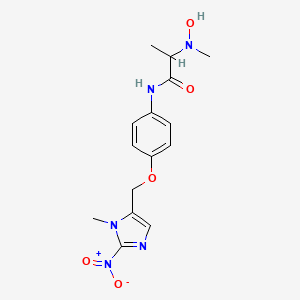
![Sodium;3-[(3R,4S,5S,7R)-7-[(3S,5S)-5-ethyl-5-[(5R,6S)-5-ethyl-5-hydroxy-6-methyloxan-2-yl]-3-methyloxolan-2-yl]-4-hydroxy-3,5-dimethyl-6-oxononyl]-6-methyl-2,4-dinitrophenolate](/img/structure/B1679461.png)
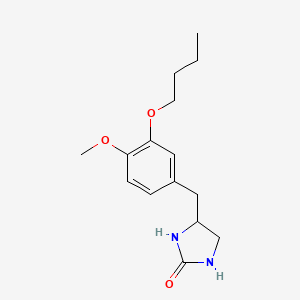
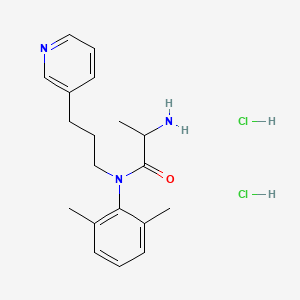
![6-(2-Chlorophenyl)-4h-imidazo[1,5-a][1,4]benzodiazepine-3-carboxamide](/img/structure/B1679466.png)
![5-[4-(4-Nitrophenyl)piperazin-1-yl]-5-(4-phenylphenyl)-1,3-diazinane-2,4,6-trione](/img/structure/B1679473.png)
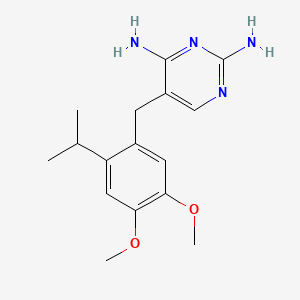
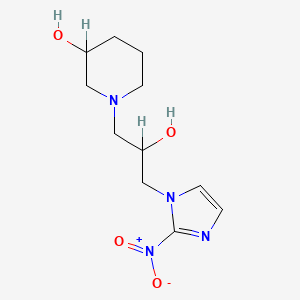

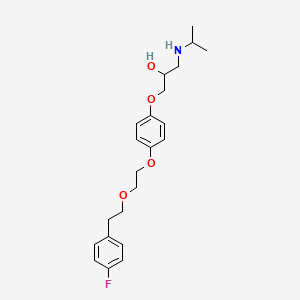

![[[1-[N-Hydroxy-acetamidyl]-3-methyl-butyl]-carbonyl-leucinyl]-alanine ethyl ester](/img/structure/B1679480.png)
